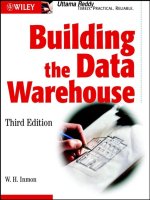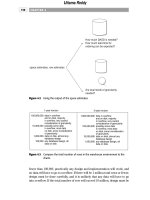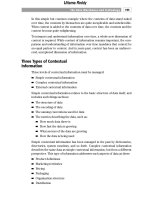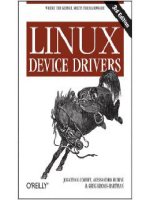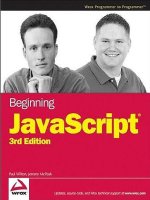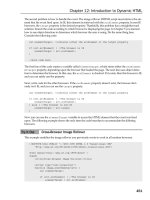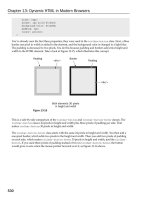Professional C# Third Edition phần 1 ppt
Bạn đang xem bản rút gọn của tài liệu. Xem và tải ngay bản đầy đủ của tài liệu tại đây (2.41 MB, 140 trang )
Simpo PDF Merge and Split Unregistered Version -
Professional C#
Third Edition
Simon Robinson
Christian Nagel
Jay Glynn
Morgan Skinner
Karli Watson
Bill Evjen
01 557599 FM.qxd 4/29/04 11:32 AM Page iii
Simpo PDF Merge and Split Unregistered Version -
01 557599 FM.qxd 4/29/04 11:32 AM Page ii
Simpo PDF Merge and Split Unregistered Version -
Professional C#
Third Edition
01 557599 FM.qxd 4/29/04 11:32 AM Page i
Simpo PDF Merge and Split Unregistered Version -
01 557599 FM.qxd 4/29/04 11:32 AM Page ii
Simpo PDF Merge and Split Unregistered Version -
Professional C#
Third Edition
Simon Robinson
Christian Nagel
Jay Glynn
Morgan Skinner
Karli Watson
Bill Evjen
01 557599 FM.qxd 4/29/04 11:32 AM Page iii
Simpo PDF Merge and Split Unregistered Version -
Professional C#, Third Edition
Published by
Wiley Publishing, Inc.
10475 Crosspoint Boulevard
Indianapolis, IN 46256
www.wiley.com
Copyright © 2004 by Wiley Publishing, Inc., Indianapolis, Indiana. All rights reserved.
Published simultaneously in Canada
No part of this publication may be reproduced, stored in a retrieval system, or transmitted in any form or by
any means, electronic, mechanical, photocopying, recording, scanning, or otherwise, except as permitted
under Section 107 or 108 of the 1976 United States Copyright Act, without either the prior written permission
of the Publisher, or authorization through payment of the appropriate per-copy fee to the Copyright Clear-
ance Center, Inc., 222 Rosewood Drive, Danvers, MA 01923, (978) 750-8400, fax (978) 646-8600. Requests to the
Publisher for permission should be addressed to the Legal Department, Wiley Publishing, Inc., 10475 Cross-
point Blvd., Indianapolis, IN 46256, (317) 572-3447, fax (317) 572-4447, E-mail:
LIMIT OF LIABILITY/DISCLAIMER OF WARRANTY: THE PUBLISHER AND THE AUTHOR MAKE
NO REPRESENTATIONS OR WARRANTIES WITH RESPECT TO THE ACCURACY OR COMPLETENESS
OF THE CONTENTS OF THIS WORK AND SPECIFICALLY DISCLAIM ALL WARRANTIES, INCLUDING
WITHOUT LIMITATION WARRANTIES OF FITNESS FOR A PARTICULAR PURPOSE. NO WARRANTY
MAY BE CREATED OR EXTENDED BY SALES OR PROMOTIONAL MATERIALS. THE ADVICE AND
STRATEGIES CONTAINED HEREIN MAY NOT BE SUITABLE FOR EVERY SITUATION. THIS WORK IS
SOLD WITH THE UNDERSTANDING THAT THE PUBLISHER IS NOT ENGAGED IN RENDERING
LEGAL, ACCOUNTING, OR OTHER PROFESSIONAL SERVICES. IF PROFESSIONAL ASSISTANCE IS
REQUIRED, THE SERVICES OF A COMPETENT PROFESSIONAL PERSON SHOULD BE SOUGHT.
NEITHER THE PUBLISHER NOT THE AUTHOR SHALL BE LIABLE FOR DAMAGES ARISING HERE-
FROM. THE FACT THAT AN ORGANIZATION OR WEBSITE IS REFERRED TO IN THIS WORK AS A
CITATION AND/OR A POTENTIAL SOURCE OF FURTHER INFORMATION DOES NOT MEAN THAT
THE AUTHOR OR THE PUBLISHER ENDORSES THE INFORMATION THE ORGANIZATION OR
WEBSITE MAY PROVIDE OR RECOMMENDATIONS IT MAY MAKE. FURTHER, READERS SHOULD
BE AWARE THAT INTERNET WEBSITES LISTED IN THIS WORK MAY HAVE CHANGED OR DISAP-
PEARED BETWEEN WHEN THIS WORK WAS WRITTEN AND WHEN IT IS READ.
For general information on our other products and services please contact our Customer Care Department
within the United States at (800) 762-2974, outside the United States at (317) 572-3993 or fax (317) 572-4002.
Trademarks: Wiley, the Wiley Publishing logo, Wrox, the Wrox logo, and Programmer to Programmer are
trademarks or registered trademarks of John Wiley & Sons, Inc. and/or its affiliates. All other trademarks
are the property of their respective owners. Wiley Publishing, Inc., is not associated with any product or
vendor mentioned in this book.
Wiley also publishes its books in a variety of electronic formats. Some content that appears in print may not
be available in electronic books.
Library of Congress Control Number: 2004103177
ISBN: 0-7645-5759-9
Printed in the United States of America
10 9 8 7 6 5 4 3 2 1
01 557599 FM.qxd 4/29/04 11:32 AM Page iv
Simpo PDF Merge and Split Unregistered Version -
About the Authors
Simon Robinson
Simon Robinson is the editor-in-chief of ASP Today, one of the leading sites
related to Web programming on the Windows platform.
Simon’s first experience of commercial computer programming was in the
early 1980s, when a computer project he was working on at college became
the school’s student timetabling program, running on the BBC Micro. Later
he studied for a Ph.D. in physics and subsequently spent a couple of years
working as a university physics researcher. From there he moved on to work-
ing as a computer programmer, then writing books about programming, and
finally on to his present job at ASP Today.
He has an extremely broad experience of programming on Windows. These days his core specialty is .NET
programming. He is comfortable coding in C++, C#, VB, and IL, and has skills ranging from graphics and
Windows Forms to ASP.NET to directories and data access to Windows services and the native Windows API.
Simon lives in Lancaster, UK. His outside interests include theater, dance, performing arts, and politics.
You can visit Simon’s Web site, .
Christian Nagel
Christian Nagel is an independent software architect and developer who
offers training and consulting on how to design and develop Microsoft .NET
solutions. He looks back to more than 15 years’ experience as a developer
and software architect. Christian started his computing career with PDP 11
and VAX/VMS platforms, covering a variety of languages and platforms.
Since the year 2000—when .NET was just a technology preview—he has
been working with various .NET technologies to build distributed solutions.
With his profound knowledge of Microsoft technologies, he has also written
numerous .NET books; is certified as Microsoft Certified Trainer (MCT),
Solution Developer (MCSD), and Systems Engineer (MCSE); and is the
Microsoft Regional Director for Austria. Christian is a speaker at international conferences (TechED,
DevDays, VCDC) and is the regional manager of INETA Europe (International .NET User Group
Association) supporting .NET user groups. You can contact Christian via his Web site,
.
Jay Glynn
Jay Glynn started writing software nearly 20 years ago, writing applications
for the PICK operating system using PICK basic. Since then, he has created
software using Paradox PAL and Object PAL, Delphi, VBA, Visual Basic, C,
C++, Java, and of course C#. He is currently a Project coordinator and
Architect for a large financial services company in Nashville, Tennessee,
working on software for the TabletPC platform. He can be
contacted at
01 557599 FM.qxd 4/29/04 11:32 AM Page v
Simpo PDF Merge and Split Unregistered Version -
Morgan Skinner
Morgan Skinner began his computing career at a tender age on a Sinclair
ZX80 at school, where he was underwhelmed by some code a teacher had
written and so began programming in assembly language. After getting
hooked on Z80 (which he believes is far better than those paltry 3 registers on
the 6502), he graduated through the school’s ZX81s to his own ZX Spectrum.
Since then he’s used all sorts of languages and platforms, including VAX
Macro Assembler, Pascal, Modula2, Smalltalk, X86 assembly language,
PowerBuilder, C/C++, VB, and currently C#. He’s been programming in
.NET since the PDC release in 2000, and liked it so much, he joined Microsoft in 2001. He now works in
Premier Support for Developers and spends most of his time assisting customers with C#.
You can reach Morgan at
.
Karli Watson
Karli Watson is a freelance author and the technical director of 3form Ltd
(
). Despite starting out by studying nanoscale
physics, the lure of cold, hard cash proved too much and dragged Karli into
the world of computing. He has since written numerous books on .NET and
related technologies, SQL, mobile computing, and a novel that has yet to see
the light of day (but that doesn’t have any computers in it). Karli is also
known for his multicolored clothing, is a snowboarding enthusiast, and still
wishes he had a cat.
Bill Evjen
Bill Evjen is an active proponent of the .NET technologies and community-
based learning initiatives for .NET. He has been actively involved with .NET
since the first bits were released in 2000 and has since become president of
the St. Louis .NET User Group (
). Bill is
also the founder and executive director of the International .NET ssociation
(
), which represents more than 125,000 members
worldwide. Based in St. Louis, Missouri, USA, Bill is an acclaimed author
and speaker on ASP.NET and XML Web services. He has written XML Web
Services for ASP.NET, Web Services Enhancements: Understanding the WSE for
Enterprise Applications, Visual Basic .NET Bible, and ASP.NET Professional
Secrets (all published by Wiley). Bill is a Technical Director for Reuters, the
international news and financial services company. He graduated from Western Washington University
in Bellingham, Washington, with a Russian language degree. You can reach Bill at
Contributor
Allen Jones
Allen Jones has a career spanning 15 years that covers a broad range of IT disciplines, including enter-
prise management, solution and enterprise architecture, and project management. But software develop-
ment has always been Allen’s passion. Allen has architected and developed Microsoft Windows–based
solutions since 1990, including a variety of e-commerce, trading, and security systems.
Allen has co-authored four popular .NET books including the C# Programmer's Cookbook (Microsoft
Press) and Programming .NET Security (O’Reilly), and he is actively involved in the development of
courseware for Microsoft Learning covering emerging .NET technologies.
01 557599 FM.qxd 4/29/04 11:32 AM Page vi
Simpo PDF Merge and Split Unregistered Version -
Credits
Vice President and Executive Group Publisher
Richard Swadley
Vice President and Executive Publisher
Bob Ipsen
Vice President and Publisher
Joseph B. Wikert
Executive Editorial Director
Mary Bednarek
Acquisitions Editors
Sharon Cox
Katie Mohr
Editorial Manager
Kathryn A. Malm
Development Editor
Sharon Nash
Production Editor
Eric Newman
Text Design & Composition
Wiley Indianapolis Composition Services
01 557599 FM.qxd 4/29/04 11:32 AM Page vii
Simpo PDF Merge and Split Unregistered Version -
01 557599 FM.qxd 4/29/04 11:32 AM Page viii
Simpo PDF Merge and Split Unregistered Version -
Contents
Introduction xxvii
Part I: The C# Language 1
Chapter 1: .NET Architecture 3
The Relationship of C# to .NET 4
The Common Language Runtime 4
Advantages of Managed Code 4
A Closer Look at Intermediate Language 7
Support for Object Orientation and Interfaces 8
Distinct Value and Reference Types 9
Strong Data Typing 9
Error Handling with Exceptions 16
Use of Attributes 17
Assemblies 17
Private Assemblies 18
Shared Assemblies 19
Reflection 19
.NET Framework Classes 19
Namespaces 21
Creating .NET Applications Using C# 21
Creating ASP.NET Applications 21
Creating Windows Forms 24
Windows Services 24
The Role of C# in the .NET Enterprise Architecture 24
Summary 26
Chapter 2: C# Basics 29
Before We Start 30
Our First C# Program 30
The Code 30
Compiling and Running the Program 31
01 557599 FM.qxd 4/29/04 11:32 AM Page ix
Simpo PDF Merge and Split Unregistered Version -
x
Contents
A Closer Look 31
Variables 34
Initialization of Variables 34
Variable Scope 35
Constants 38
Predefined Data Types 39
Value Types and Reference Types 39
CTS Types 40
Predefined Value Types 41
Predefined Reference Types 44
Flow Control 47
Conditional Statements 47
Loops 51
Jump Statements 54
Enumerations 55
Arrays 57
Namespaces 58
The using Statement 59
Namespace Aliases 60
The Main() Method 61
Multiple Main() Methods 61
Passing Arguments to Main() 62
More on Compiling C# Files 63
Console I/O 65
Using Comments 67
Internal Comments Within the Source Files 67
XML Documentation 68
The C# Preprocessor Directives 70
#define and #undef 70
#if, #elif, #else, and #endif 71
#warning and #error 72
#region and #endregion 72
#line 72
C# Programming Guidelines 73
Rules for Identifiers 73
Usage Conventions 74
Summary 81
Chapter 3: Objects and Types 83
Classes and Structs 84
Class Members 85
Data Members 85
Function Members 85
01 557599 FM.qxd 4/29/04 11:32 AM Page x
Simpo PDF Merge and Split Unregistered Version -
xi
Contents
readonly Fields 99
Structs 101
Structs Are Value Types 102
Structs and Inheritance 103
Constructors for Structs 103
The Object Class 104
System.Object Methods 104
The ToString() Method 105
Summary 107
Chapter 4: Inheritance 109
Types of Inheritance 109
Implementation Versus Interface Inheritance 109
Multiple Inheritance 110
Structs and Classes 110
Implementation Inheritance 111
Virtual Methods 112
Hiding Methods 113
Calling Base Versions of Functions 114
Abstract Classes and Functions 115
Sealed Classes and Methods 115
Constructors of Derived Classes 116
Modifiers 122
Visibility Modifiers 122
Other Modifiers 123
Interfaces 123
Defining and Implementing Interfaces 125
Derived Interfaces 128
Summary 130
Chapter 5: Operators and Casts 131
Operators 131
Operator Shortcuts 133
The Ternary Operator 134
The checked and unchecked Operators 134
The is Operator 135
The as Operator 136
The sizeof Operator 136
The typeof Operator 136
01 557599 FM.qxd 4/29/04 11:32 AM Page xi
Simpo PDF Merge and Split Unregistered Version -
xii
Contents
Operator Precedence 137
Type Safety 137
Type Conversions 138
Boxing and Unboxing 141
Comparing Objects for Equality 142
Comparing Reference Types for Equality 142
The ReferenceEquals() Method 142
The virtual Equals() Method 143
The static Equals() Method 143
Comparison Operator (==) 143
Comparing Value Types for Equality 143
Operator Overloading 144
How Operators Work 145
Operator Overloading Example: The Vector Struct 146
Which Operators Can You Overload? 153
User-Defined Casts 154
Implementing User-Defined Casts 155
Multiple Casting 161
Summary 165
Chapter 6: Delegates and Events 167
Delegates 167
Using Delegates in C# 169
SimpleDelegate Example 172
BubbleSorter Example 174
Multicast Delegates 177
Events 179
The Receiver’s View of Events 180
Generating Events 182
Summary 186
Chapter 7: Memory Management and Pointers 187
Memory Management under the Hood 187
Value Data Types 188
Reference Data Types 190
Garbage Collection 192
Freeing Unmanaged Resources 193
Destructors 193
The IDisposable Interface 195
01 557599 FM.qxd 4/29/04 11:32 AM Page xii
Simpo PDF Merge and Split Unregistered Version -
xiii
Contents
Implementing IDisposable and a Destructor 196
Unsafe Code 197
Pointers 198
Pointer Example: PointerPlayaround 207
Using Pointers to Optimize Performance 212
Summary 216
Chapter 8: Strings and Regular Expressions 217
System.String 218
Building Strings 219
Format Strings 223
Regular Expressions 229
Introduction to Regular Expressions 229
The RegularExpressionsPlayaround Example 230
Displaying Results 233
Matches, Groups, and Captures 234
Summary 237
Chapter 9: Collections 239
Examining Groups of Objects 239
Array Lists 240
Collections 241
Dictionaries 245
Summary 256
Chapter 10: Reflection 257
Custom Attributes 258
Writing Custom Attributes 258
Custom Attribute Example: WhatsNewAttributes 262
Reflection 265
The System.Type Class 266
The TypeView Example 268
The Assembly Class 271
Completing the WhatsNewAttributes Sample 272
Summary 276
01 557599 FM.qxd 4/29/04 11:32 AM Page xiii
Simpo PDF Merge and Split Unregistered Version -
xiv
Contents
Chapter 11: Errors and Exceptions 277
Looking into Errors and Exception Handling 277
Exception Classes 278
Catching Exceptions 280
User-Defined Exception Classes 290
Summary 297
Part II: The .NET Environment 299
Chapter 12: Visual Studio .NET 301
Working with Visual Studio .NET 2003 301
Creating a Project 304
Solutions and Projects 311
Windows Application Code 314
Reading in Visual Studio 6 Projects 314
Exploring and Coding a Project 315
Building a Project 326
Debugging 331
Other .NET Tools 334
The ASP.NET Web Matrix Project 335
WinCV 335
Summary 337
Chapter 13: Assemblies 339
What Are Assemblies? 339
The Answer to DLL Hell 340
Features of Assemblies 341
Application Domains and Assemblies 341
Assembly Structure 344
Assembly Manifests 346
Namespaces, Assemblies, and Components 346
Private and Shared Assemblies 347
Viewing Assemblies 347
Building Assemblies 348
Cross-Language Support 353
The CTS and the CLS 353
Language Independence in Action 354
CLS Requirements 364
01 557599 FM.qxd 4/29/04 11:32 AM Page xiv
Simpo PDF Merge and Split Unregistered Version -
xv
Contents
Global Assembly Cache 366
Native Image Generator 366
Global Assembly Cache Viewer 367
Global Assembly Cache Utility (gacutil.exe) 368
Creating Shared Assemblies 369
Shared Assembly Names 369
Creating a Shared Assembly 371
Configuration 376
Configuration Categories 376
Versioning 377
Configuring Directories 387
Summary 390
Chapter 14: .NET Security 391
Code Access Security 392
Code Groups 393
Code Access Permissions and Permissions Sets 399
Policy Levels: Machine, User, and Enterprise 403
Support for Security in the Framework 405
Demanding Permissions 406
Requesting Permissions 407
Implicit Permission 410
Denying Permissions 411
Asserting Permissions 412
Creating Code Access Permissions 414
Declarative Security 414
Role-Based Security 415
The Principal 415
Windows Principal 416
Roles 417
Declarative Role-Based Security 418
Managing Security Policy 419
The Security Configuration File 419
Managing Code Groups and Permissions 423
Turning Security On and Off 423
Resetting Security Policy 423
Creating a Code Group 423
Deleting a Code Group 424
Changing a Code Group’s Permissions 424
Creating and Applying Permissions Sets 425
Distributing Code Using a Strong Name 427
01 557599 FM.qxd 4/29/04 11:32 AM Page xv
Simpo PDF Merge and Split Unregistered Version -
xvi
Contents
Distributing Code Using Certificates 429
Managing Zones 435
Summary 437
Chapter 15: Threading 439
Threading 439
Applications with Multiple Threads 441
Manipulating Threads 441
The ThreadPlayaround Sample 444
Thread Priorities 448
Synchronization 449
Summary 453
Chapter 16: Distributed Applications with .NET Remoting 455
What Is .NET Remoting? 456
Application Types and Protocols 456
CLR Object Remoting 457
.NET Remoting Overview 457
Contexts 460
Activation 461
Attributes and Properties 461
Communication between Contexts 462
Remote Objects, Clients, and Servers 462
Remote Objects 462
A Simple Server 464
A Simple Client 465
.NET Remoting Architecture 466
Channels 466
Formatters 470
ChannelServices and RemotingConfiguration 471
Object Activation 472
Message Sinks 476
Passing Objects in Remote Methods 476
Lifetime Management 481
Miscellaneous .NET Remoting Features 484
Configuration Files 484
Hosting Applications 494
Classes, Interfaces, and SoapSuds 495
Asynchronous Remoting 498
Remoting and Events 499
Call Contexts 505
Summary 507
01 557599 FM.qxd 4/29/04 11:32 AM Page xvi
Simpo PDF Merge and Split Unregistered Version -
xvii
Contents
Chapter 17: Localization 509
Namespace System.Globalization 510
Unicode Issues 510
Cultures and Regions 511
Cultures in Action 516
Sorting 520
Resources 522
Creating Resource Files 522
ResGen 523
ResourceWriter 523
Using Resource Files 524
The System.Resources Namespace 527
Localization Example Using Visual Studio .NET 527
Outsourcing Translations 533
Changing the Culture Programmatically 534
Using Binary Resource Files 536
Using XML Resource Files 537
Automatic Fallback for Resources 539
Globalization and Localization with ASP.NET 539
A Custom Resource Reader 540
Creating a DatabaseResourceReader 541
Creating a DatabaseResourceSet 542
Creating a DatabaseResourceManager 543
Client Application for DatabaseResourceReader 544
Summary 544
Chapter 18: Deployment 545
Designing for Deployment 545
Deployment Options 546
Xcopy 546
Copy Project 546
Deployment Projects 546
Deployment Requirements 546
Simple Deployment 547
Xcopy 548
Xcopy and Web Applications 548
Copy Project 550
Installer Projects 551
What Is Windows Installer? 551
Creating Installers 552
Advanced Options 562
Summary 569
01 557599 FM.qxd 4/29/04 11:32 AM Page xvii
Simpo PDF Merge and Split Unregistered Version -
xviii
Contents
Part III: Windows Forms 571
Chapter 19: Windows Forms 573
Creating a Windows Form Application 574
Control Class 579
Size and Location 580
Appearance 580
User Interaction 580
Windows Functionality 582
Miscellaneous Functionality 582
Class Hierarchy 582
Standard Controls and Components 584
Forms 598
Form Class 599
Multiple Document Interface (MDI) 607
Custom Controls 610
Summary 622
Chapter 20: Graphics with GDI+ 623
Understanding Drawing Principles 624
GDI and GDI+ 624
Drawing Shapes 626
Painting Shapes Using OnPaint() 629
Using the Clipping Region 630
Measuring Coordinates and Areas 632
Point and PointF 632
Size and SizeF 634
Rectangle and RectangleF 635
Region 636
A Note about Debugging 637
Drawing Scrollable Windows 638
World, Page, and Device Coordinates 644
Colors 645
Red-Green-Blue (RGB) Values 645
The Named Colors 646
Graphics Display Modes and the Safety Palette 646
The Safety Palette 647
Pens and Brushes 648
Brushes 648
Pens 649
01 557599 FM.qxd 4/29/04 11:32 AM Page xviii
Simpo PDF Merge and Split Unregistered Version -
xix
Contents
Drawing Shapes and Lines 650
Displaying Images 652
Issues When Manipulating Images 655
Drawing Text 655
Simple Text Example 656
Fonts and Font Families 657
Example: Enumerating Font Families 659
Editing a Text Document: The CapsEditor Sample 661
The Invalidate() Method 666
Calculating Item Sizes and Document Size 667
OnPaint() 668
Coordinate Transforms 670
Responding to User Input 671
Printing 675
Implementing Print and Print Preview 676
Summary 680
Part IV: Data 683
Chapter 21: Data Access with .NET 685
ADO.NET Overview 685
Namespaces 686
Shared Classes 686
Database-Specific Classes 687
Using Database Connections 688
Using Connections Efficiently 689
Transactions 692
Commands 693
Executing Commands 694
Calling Stored Procedures 698
Fast Data Access: The Data Reader 701
Managing Data and Relationships: The DataSet Class 704
Data Tables 704
Data Columns 705
Data Relationships 711
Data Constraints 713
XML Schemas 715
Generating Code with XSD 716
Populating a DataSet 721
Populating a DataSet Class with a Data Adapter 722
Populating a DataSet from XML 723
01 557599 FM.qxd 4/29/04 11:32 AM Page xix
Simpo PDF Merge and Split Unregistered Version -
xx
Contents
Persisting DataSet Changes 723
Updating with Data Adapters 724
Writing XML Output 726
Working with ADO.NET 728
Tiered Development 728
Key Generation with SQL Server 730
Naming Conventions 732
Summary 734
Chapter 22: Viewing .NET Data 735
The DataGrid Control 735
Displaying Tabular Data 735
Data Sources 738
DataGrid Class Hierarchy 746
Data Binding 750
Simple Binding 750
Data-Binding Objects 751
Visual Studio.NET and Data Access 757
Creating a Connection 758
Selecting Data 759
Generating a DataSet 762
Updating the Data Source 763
Building a Schema 764
Other Common Requirements 770
Summary 778
Chapter 23: Manipulating XML 781
XML Standards Support in .NET 782
Introducing the System.Xml Namespace 782
Using MSXML in .NET 783
Using System.Xml Classes 786
Reading and Writing Streamed XML 786
Using the XmlTextReader Class 787
Using the XmlValidatingReader Class 791
Using the XmlTextWriter Class 794
Using the DOM in .NET 795
Using the XmlDocument Class 797
Using XPath and XSLT in .NET 802
The System.Xml.XPath Namespace 803
The System.Xml.Xsl Namespace 807
01 557599 FM.qxd 4/29/04 11:32 AM Page xx
Simpo PDF Merge and Split Unregistered Version -
xxi
Contents
XML and ADO.NET 812
Converting ADO.NET Data to XML 812
Converting XML to ADO.NET Data 820
Reading and Writing a DiffGram 822
Serializing Objects in XML 825
Serialization without Source Code Access 833
Summary 836
Chapter 24: Working with Active Directory 837
The Architecture of Active Directory 838
Features 838
Active Directory Concepts 839
Characteristics of Active Directory Data 843
Schema 843
Administration Tools for Active Directory 845
Active Directory Users and Computers 845
ADSI Edit 846
Active Directory Service Interfaces (ADSI) 847
Programming Active Directory 848
Classes in System.DirectoryServices 849
Binding 849
Getting Directory Entries 854
Object Collections 855
Cache 857
Creating New Objects 857
Updating Directory Entries 858
Accessing Native ADSI Objects 859
Searching in Active Directory 860
Searching for User Objects 864
User Interface 864
Get the Schema Naming Context 864
Get the Property Names of the User Class 866
Search for User Objects 867
Summary 869
Part V: Web Programming 871
Chapter 25: ASP.NET Pages 873
ASP.NET Introduction 874
State Management in ASP.NET 875
01 557599 FM.qxd 4/29/04 11:32 AM Page xxi
Simpo PDF Merge and Split Unregistered Version -
xxii
Contents
ASP.NET Web Forms 875
ASP.NET Server Controls 880
ADO.NET and Data Binding 892
Updating the Event-Booking Application 893
More on Data Binding 901
Application Configuration 906
Summary 907
Chapter 26: Web Services 909
SOAP 910
WSDL 911
Web Services 913
Exposing Web Services 913
Consuming Web Services 916
Extending the Event-Booking Example 918
The Event-Booking Web Service 919
The Event-Booking Client 922
Exchanging Data Using SOAP Headers 924
Summary 929
Chapter 27: User Controls and Custom Controls 931
User Controls 932
A Simple User Control 932
Custom Controls 939
Custom Control Project Configuration 940
Basic Custom Controls 944
Creating a Composite Custom Control 949
A Straw Poll Control 951
The Candidate Controls 953
The StrawPoll Control Builder 954
Straw Poll Style 955
The Straw Poll Control 956
Summary 962
Part VI: Interop 963
Chapter 28: COM Interoperability 965
.NET and COM 966
Metadata 966
Freeing Memory 966
01 557599 FM.qxd 4/29/04 11:32 AM Page xxii
Simpo PDF Merge and Split Unregistered Version -


